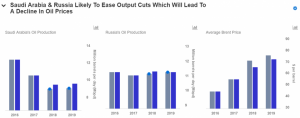 The first half of 2018 has seen a rebound in oil prices. The Organization of Petroleum Exporting Countries and its allied Non-OPEC nations’ decision to extend the oil output cuts until the end of this year has caused the Brent crude oil prices to touch $80 per barrel for the first time since 2014. This has helped the oil and gas players across the globe (including oil companies such as BP, Exon, and Chevron) to recover their lost wealth, and including Saudi Arabia and Russia who had agreed to cut their output in order to boost oil prices. Now that the oil prices have recovered strongly, it is rumored that these countries are likely to pull back a large portion of their output cuts, as much as 1 million barrels per day (Mbpd) in the upcoming OPEC meeting later in this month.
The first half of 2018 has seen a rebound in oil prices. The Organization of Petroleum Exporting Countries and its allied Non-OPEC nations’ decision to extend the oil output cuts until the end of this year has caused the Brent crude oil prices to touch $80 per barrel for the first time since 2014. This has helped the oil and gas players across the globe (including oil companies such as BP, Exon, and Chevron) to recover their lost wealth, and including Saudi Arabia and Russia who had agreed to cut their output in order to boost oil prices. Now that the oil prices have recovered strongly, it is rumored that these countries are likely to pull back a large portion of their output cuts, as much as 1 million barrels per day (Mbpd) in the upcoming OPEC meeting later in this month.
As part of the OPEC deal, the cartel members, along with its allies, have curtailed their oil supply by 1.8 million barrels per day (Mbpd) since the beginning of 2017. They had further agreed to extend these cuts until the end of 2018 with an aim to sustain their declining economies. However, the recent reinforcement of sanctions on Iran by the US government is expected to stall the country’s output, which was otherwise expected to shoot up sharply. In addition, the financial crisis in Venezuela has further accentuated the decline in the overall OPEC oil output. Thus, in order to compensate for the loss in oil supply from these two member countries, Saudi Arabia – key driver of the production cuts, and Russia – largest Non-OPEC oil producer, are in talks to ease off the production cuts at the next OPEC meeting. This also appears as a response to protect the cartel’s diminishing share in the oil market due to the steeply rising US oil supply.
Below we present our interactive dashboard predicting our base forecast for Brent oil prices over the next couple of years and depict how an expected ease off in the production cuts could impact these prices.

Source: “How Will An Increase In Oil Output By Russia And OPEC Impact Oil Prices?”, Forbes
